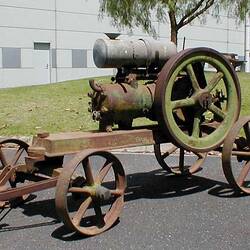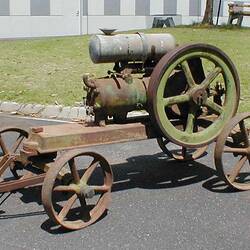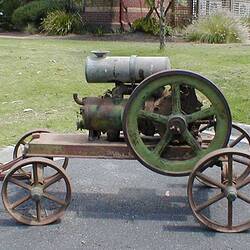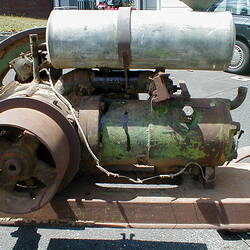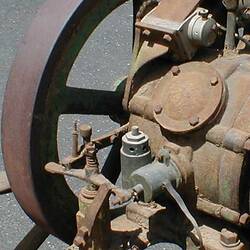Summary
Horizontal single-cylinder 2-stroke petrol engine, rated at between 4 & 6 h.p., with approx. 5" bore x 6" stroke, built by Jelbart Bros., Engineers, Ballarat, circa 1911. Identified as serial no.142, this engine is an example of Jelbarts' early Type A model, produced between 1909-c.1913. The engine is mounted on a transport with cast-iron chassis or bedplate and cast-iron wheels. It has a single straight-spoked flywheel. The engine is unrestored and appears to be essentially complete, with the exception of the cooling tank and still has original paintwork, though it is faded.
Significance
Jelbart Brothers of Ballarat were one of the most prominent Australian engine builders during the period 1910 to 1940, playing a leading role in the introduction of the internal combustion engine, which revolutionised Australian farming, road transport and road construction during the first half of the 20th century.
Founded by Frank Stafford Jelbart & Joseph Everett Jelbart in about 1909, the company initially made portable & stationary petrol engines in a range of five sizes from 3 to 12½ h.p.. Most were used by farmers, however, they also found application in dairies, factories, quarries and electricity generation. Marketed as "the farmer's boy", Jelbart engines soon gained a reputation for reliable and economical operation and were claimed by the manufacturers to be "the most powerful engine on the market". This claim had good basis, because being a 2-stroke design, they produced twice the power output for a given size and weight of other typical 4-stroke engines of the day. By 1917, Jelbarts had made over 600 engines and adapted their original design to operate economically on cheaper fuels such as kerosene, suction gas and light crude oil. From 1914, Jelbarts also adapted their engine to drive tractors and road rollers of their own construction, making them the second Australian company to attempt manufacture in each of these fields.
The business was reformed as Jelbarts Pty. Ltd. in 1915, and around this time developed an association with Ralph Sadleir Falkiner of the Falkiner Electric Co., who acted as distribution agents for Jelbart engines and tractors in Melbourne and interstate. Jelbarts remained in business at Ballarat until the 1950s, although the firm ran into financial difficulties during the mid 1920s and by the late 1940s had dropped manufacturing to concentrate mainly on repairs & spare parts. It is not known exactly how many engines the firm built, however, the highest recorded serial number is 1,550.
This engine is an example of Jelbart's early Type A model produced from 1909-c.1913. Its serial number is 142, making it the oldest known surviving numbered Jelbart engine still in original (unmodified) form without later improvements that were often added to early engines when sent back to the works for overhaul. It incorporates their patented two-stroke design with crank-case compression and stepped-piston with deflector crown for enhanced air-scavenging. The engine also has early Jelbart features such as the cast-iron transport chassis or bedplate, carburettor mounted on the rear of the crankcase, single flywheel, an original drip-feed crankcase oiler and what appears to be much of its original paintwork. There are about 70 known Jelbart portable engines still in existence, though fewer than 20 of these are of the early Type A model. Most surviving Jelbart engines have been restored by private collectors and they regularly turn up at rallies, although they are much rarer than other makes such as Ronaldson & Tippett. It is very rare for an unrestored early Jelbart engine to come onto the market.
More Information
-
Collecting Areas
-
Acquisition Information
Purchase from Aston & Joyce Pty Ltd, Nov 2001
-
Manufacturer
Jelbart Bros., Dana Street, Ballarat, Victoria, Australia, circa 1911
-
Inscriptions
Stamped "142" on cylinder flange.
-
Model Name or Number
-
Classification
Mechanical engineering, Internal combustion power, Petrol engines
-
Category
-
Discipline
-
Type of item
-
Approximate Dimensions
1760 mm (Length), 1900 mm (Width), 1200 mm (Height), 700 kg (Weight)
Weight and Height approximate
-
Keywords
Innovation & Design, Internal Combustion Engines, Inventions, Petrol Engines

